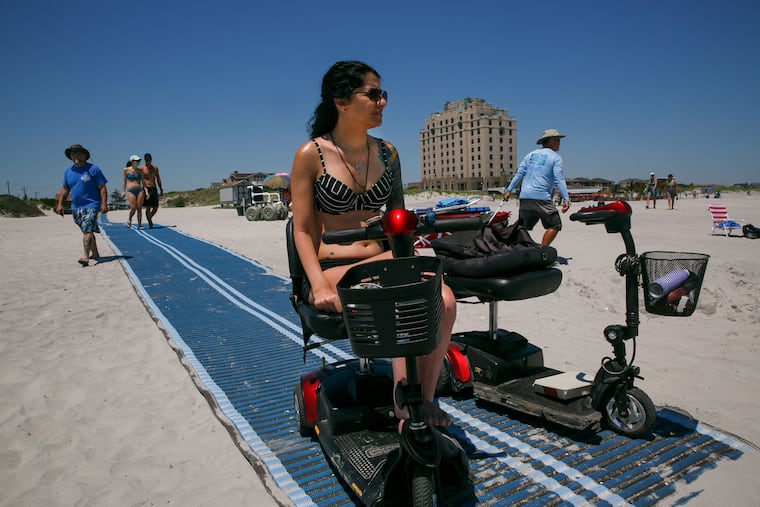Getting her wheelchair on the beach was a struggle. Brigantine just made it easier
Getting on the beach was a struggle for her. Brigantine just made it easier.

BRIGANTINE, N.J. — As a teenager in leg braces, Bernadette Scarduzio struggled to walk across the hot sand at the Brigantine beach. Shaking, she would lean on relatives for support as she kept her eye on the finish line: the distant ocean.
Scarduzio, now 39 and using a wheelchair, was diagnosed as a child with Charcot-Marie-Tooth disorder (CMT), a hereditary disease that causes her nerves and muscles to slowly deteriorate. She has always loved the Shore and its "healing qualities," but beach days are stressful. Reaching the water involves renting a beach scooter for about $80, finding a friend to push her, and losing some of her independence.
"It's hot and hard, and takes a lot of energy," said Scarduzio, a Philadelphia resident whose family owns a summer home in Brigantine. Friends and relatives have told Scarduzio that pushing her across the sand in a beach wheelchair can be exhausting.
But that recently changed.
Last week, the city installed a 350-foot-long, 5-foot-wide mat at the 16th Street beach entrance that stretches to the high-tide line, where firmer sand is easier to roll on. The roll-up mat is meant to help wheelchair users, many of whom have avoided the beach.
The deep blue Mobi-Mat, made by Deschamps Mat Systems of Cedar Grove, cost $14,000 and does not sink into the sand. The nonslip walkway, partially funded through a $2,000 grant from the Brigantine Elks, also makes it easier for parents with strollers and everyday pedestrians to access the beach.
"With the mat, I'm more independent, and it makes me want to go to the beach," said Scarduzio, who brought the idea to the Brigantine City Council last year. A memorial bench to her father, who also had CMT and who died in 2009, sits at the north-end seawall.
"If my dad was here, he'd be so happy," she said.
The mat is one of a few ways — and the most effective — that Brigantine has improved beach access for senior citizens and people with disabilities, said City Councilman Vince Sera. Nearly 30 percent of the city's population is older than 65, according to census data.
Fifteen years ago, Brigantine bought several beach wheelchairs, with large rubber wheels designed to slide across the sand. People rent the chairs on a first-come, first-serve basis and are encouraged to share, but it's still an arduous process for many.
If needed, the beach patrol helps transport people to the shoreline as well.
"We have a large senior citizen population," Sera said. "So many people told us they haven't been on the sand in 20 years."
Brigantine is one of a few Shore towns with Mobi-Mats, though it's the only one with a mat that reaches the hard sand by the surf.
About 10 years ago, Sea Isle City began installing the mats at ADA-compliant beaches at 32nd, 40th, 44th, and 63rd Streets. Now, the roughly 30-foot mats line 26 beach entrances, each at a cost of $2,700.
"It's a popular item," said city spokeswoman Katherine Custer.
Seventeen beach wheelchairs are available to rent for up to two weeks in Sea Isle City, which is packed with 40,000 people in the summer. Chairs are reserved in advance, and the fleet is usually booked through the three-month season.
The walkways and chairs, Custer said, serve different purposes. The mats get people onto the beach, while chairs are used to roam the sand. Together, they make the Shore accessible to more people in Sea Isle City, where census data show the median age is 63.
In Margate, there's a renewed push for enhanced accessibility amid the Army Corps of Engineers' beach replenishment project that created 13-foot dunes along the Shore in an attempt to protect homes from coastal storms.
In the last two years, the Margate beach patrol began offering rides to those who cannot traverse the dunes. A handful of people use the service each day, said Beach Patrol Capt. Mike Cincotta.
"We used to watch the water and protected swimmers. … Getting to and from the beach was the responsibility of the person coming to the beach," Cincotta said. "It's become an expected service now…. The amount of people we transport shot up this year."
Jay Weintraub, president of the Margate Homeowners Association, is pushing the city to purchase Mobi-Mats for every entrance. Currently, blue mats at some entrances bring beachgoers to sandy walkways made of wooden fencing that reach the start of the dunes.
The Army Corps project is stalled for the summer, but will resume in September.
The city that attracts about 40,000 people in the summer, Weintraub said, needs to offer more than a transportation service and five beach wheelchairs.
"When your beach is not accessible to people … you're affecting young families and senior citizens," he said. "It's taking away from their Shore experience."